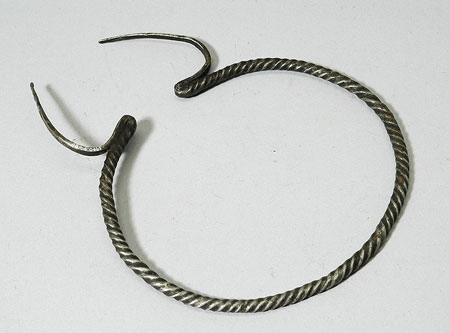Accession Number:
1940.7.080
Country:
Sudan
Region:
[Southern Sudan] [Al Istiwa'iyah] [Equatoria] Bahr el Jebel Eastern Equatoria ?Western Equatoria Langabu
Cultural Group:
Lokoya ?Irya and Owe
Date Made:
By 1940
Materials:
Iron Metal
Process:
Forged (Metal) , Twisted , Hammered , Bent
Dimensions:
Max L = 202 mm Max W = 155 mm Max Diam [internal] = 142 mm Max Diam [rod] = 5.7 mm
Weight:
101 g
Other Owners:
Samuel P. Powell
Field Collector:
Samuel P. Powell
PRM Source:
Samuel P. Powell
Acquired:
Loaned July 1940
Collected Date:
By 1940
Description:
Penannular torque made from an iron rod, round in section, that has been twisted to create a decorative spiral groove that runs along its length, with the ends hammered flat to create two tapering spikes with rectangular sections.
This rod was then bent into an oval loop with open ends, 29 mm apart, with the tapering ends folded back against the outside edge of the torque, then bent to curve back inwards in 2 long arcs.
One tip is pointed, the other has a slightly bulbous end.
The necklet is complete and intact, and currently a metallic gray colour (Pantone 877C) with only slight traces of surface rust.
It has a weight of 101 grams, and is 202 mm long, including the projecting arcs, and 155 mm wide across its outside edge; the internal diameter is 142 by 125 mm, while the rod from which it has been formed is 5.7 mm wide and 5.5 mm thick.
Collected by Samuel P. Powell from the 'Oxoriok' at Langabu, and loaned to the Pitt Rivers Museum in 1940. Oxoriok is another name for the Lokoya. For discussions of the Lokoya, see G.W.B. Huntingford, 1953, The Northern Nilo-Hamites, p. 75-78, and C.G. Seligman, Pagan Tribes, pp 340-345. The precise location of Langabu has yet to be established.
This type of necklet was worn by men. Coote has suggested that these have been shaped into the form of trained cow horns (Jeremy Coote, pers. comm. 15/1/ 2002).
Rachael Sparks 14/9/2005.
Collected by Samuel P. Powell from the 'Oxoriok' at Langabu, and loaned to the Pitt Rivers Museum in 1940. Oxoriok is another name for the Lokoya. For discussions of the Lokoya, see G.W.B. Huntingford, 1953, The Northern Nilo-Hamites, p. 75-78, and C.G. Seligman, Pagan Tribes, pp 340-345. The precise location of Langabu has yet to be established.
This type of necklet was worn by men. Coote has suggested that these have been shaped into the form of trained cow horns (Jeremy Coote, pers. comm. 15/1/ 2002).
Rachael Sparks 14/9/2005.
Primary Documentation:
Accession Book Entry
[Loans II, p.
308] - ESTATE OF S.P.
POWELL, C/O N.H.
HASLAM, Esq.
Manager, Westminster Bank, Stony Stratford, Bucks.
Collected by himself.
Data from his labels and notes.
[p.
313] 1940.7.080 - Man's neck ornament, iron.
OXORIOK, from LANGABU, EQUATORIAL PROVINCE, A[NGLO].-E[GYPTIAN].
SUDAN.
Card Catalogue Entry - There is no further information on the catalogue card [RTS 28/1/2004].
Pitt Rivers Museum label - Man's neck ornament of iron. OXORIOK LANGABU, SUDAN, Equatorial Province. S.P. Powell 1940.7.080 [brown luggage tag, tied to object; RTS 1/3/2005].
Related Documents File - Appears on undated typed list: "Oxoriok neck ornaments in brass and iron from Langabu, E[quatorial].P[rovince].". List is annotated by hand on back: "List of Curios" and "Far from complete". For the brass ornament, see 1940.7.079 [RTS 16/12/2003].
Card Catalogue Entry - There is no further information on the catalogue card [RTS 28/1/2004].
Pitt Rivers Museum label - Man's neck ornament of iron. OXORIOK LANGABU, SUDAN, Equatorial Province. S.P. Powell 1940.7.080 [brown luggage tag, tied to object; RTS 1/3/2005].
Related Documents File - Appears on undated typed list: "Oxoriok neck ornaments in brass and iron from Langabu, E[quatorial].P[rovince].". List is annotated by hand on back: "List of Curios" and "Far from complete". For the brass ornament, see 1940.7.079 [RTS 16/12/2003].



